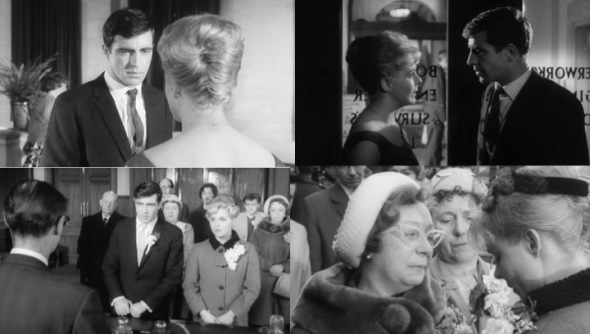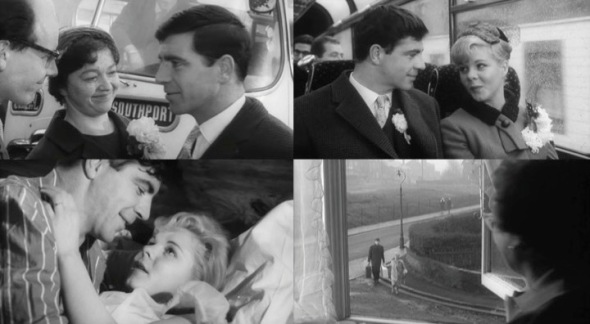Film Talk – The 1960’s Dream – Part 1
The second in my ongoing series if Film Talks I’m running at the Rothley Community Library. I decided to discuss two films this time A Kind of Loving (1962) and Midnight Cowboy (1969) both directed by John Schlesinger. Below are the notes from the night.
Tonight I’ll be taking a look at one of last months recommendations – A Kind of Loving (1962), which I noticed was directed by John Schlesinger who went onto make Midnight Cowboy (1969). I’ll start by sharing what makes a Kitchen sink drama or has otherwise been known as a British New Wave or Social Realism. Before moving onto look at A Kind of Loving and drawing comparisons with Midnight Cowboy.
So what is a Kitchen Sink Drama? I think you have to look at Britain socially first, in order to inform these films. I turned to The Social Structure of Modern Britain – E.A. Johns (1965); which is dated by today’s standards, but nonetheless allowed me to see how society was perceived at the time of writing. I first focused on the family,
“…the view currently held by many eminent writers is that the family has been stripped of the functions which are essential to its cohesion, and that parents have abnegated their responsibilities in favour of the government-run organs of the Welfare state.”
Pg. 25
These essential functions of the family are :
- Provision of a home
- Production and rearing of children
- Stable satisfaction of sex need
R.M. MacIver – Macmillan 1957
Johns continued on the family by quoting W.J.H Sprott who argued that
“…The family, under Western cultural conditions has shrunk functionally” and that the social services are basically “anti-family” in that they cater almost exclusively for the individual rather than the family as a whole. This view is supported up to a point by M.Penelope Hall when she quotes the article on Social Policy and the Family…This document remarks that the family has until recently, been given only a minor place in social policy, “and over-all effect has been to lower status of the family in the national life”. Day nurseries and school meals, for example encourage a mother to go to work, but do not encourage her to create a home for her children”
Pg.25-6
There’s an improvement in opportunities for young mothers wanting to be independent, which would have a knock on effect. Whilst also looking at increased leisure time available in modern Britain.
“…the increasing adoption of the 5-day working week and introduction of labour-saving devices in the home both mean that families have more leisure time. The characteristically democratic structure of most modern families mean that husbands and wives spend more of this time together.”
Pg. 27
I also looked at the position of women in the 60’s, first looking at the jobs they have
Married women stats
25-34 years – 2/3 are employed
35-44 years – ¾ are employed
45-54 – 2/3 are employed.
Types of work include
- distribution – insurance – banking – catering – laundries (industry jobs)
- Hairdressing – domestic service – nursing (tertiary jobs)
- Clerks – typists – shop assistance (“white-blouse brigade”)
These statistics only account for married women in employment. What about when the married couple moves away from the family home into the newly built housing estates?
“Another factor…is that when families make the sudden transition from an old-established neighbourhood with a strong social life to a virgin housing estate, they may experience a good deal of loneliness, at least initially. The wives, in particular. may miss the gossip and chatter of the streets, and see a substitute in the companionship of the office or factory”
Pg. 37
Lastly looking at marriage and divorce, which was made more accessible, however divorce was only granted under certain conditions. This passage still carries some weight today regarding the failure of marriages.
“I think the most significant element, however, is the egalitarianism which characterizes the relationship between married partners today, by contrast with the patriarchal authoritarianism which was accepted as the normal pattern in the nineteenth century…The marriage a girl enters today has far more stresses than her grandmother’s. A partnership needs much more forbearance than the situation which the wife just used to accept the idea of doing what she was told.”
Pg. 46
It does however acknowledge that number of younger couples getting married, and why. The most obvious is the reason why our main characters Vic and Ingrid in A Kind of Loving.
“In 1960, nearly 62,000 extra-maritally conceived children were born to women married for less than 8 months (usually 5 or 6). Translated into proportion of all marriages this means that one in five brides was pregnant, and it is well established that the shot-gun marriage is more likely to break down.”
Pg. 47
Johns doesn’t mention the introduction pill was made available with slowly increased access to it.
“At first it was only prescribed to married women – most older women who had already had children and wanted no more…In the past most women had to married at an early age, being expected to give up their job and become a full-time housewife and mother wile their husband went out to work. If a woman wanted to follow a career she had to give up thoughts of marriage. Now, married could, if they chose, plan a career, and rigid gender based division of roles began to change. It was the beginning of both a social and sexual revolution, and there was much talk of the ‘permissive society’ and ‘free love’”
Life in the 1960s – Mike Brown Pg. 9
So we have some social context around the Kitchen Sink Drama we know that they are focused on working class issues. If you’ve ever seen one you’ll notice they are mostly in Northern locations complete with the rich accents. They are devoid of special effects, the gloss that you get over in Hollywood or Europe lets take a closer look at the key directors of the movement. The subjects they covered were.
Now lets take a quick look at the key directors of the movement.
Tony Richardson who made Look Back in Anger (1959) mentioned during our discussion last month, it starred Richard Burton as a middle class student with grudges towards the working class.
Lindsay Anderson gave us This Sporting Life (1963) starring Richard Harris about an angry young rugby player who resists the fame and fortune that is coming his away.
Karel Reisz made possibly one of the more popular titles Saturday Night and Sunday Morning (1960) with Albert Finney about a factory worker who gets a married woman pregnant.
Then we have John Schlesinger who began his career as an actor in his early twenties before making his directorial debut with a 30-minute documentary about Waterloo station – Terminus. A year later he made his feature film debut with A Kind of Loving, which saw him work with producer Joseph Janni for the first of 6 films together. It’s also the first starring role for Alan Bates.
The film follows a young man Vic (Alan Bates) who falls for Ingrid (June Ritchie), which starts off like a school romance, the passing of notes, the boys fighting, and the social dances. That’s all until Ingrid falls pregnant after they both loose their virginity. This is when the dream of a carefree romance starts to fall away opening them up to married life. In the first few weeks of marriage they are living at her home with her mother played by Thora Hird. Who makes life difficult for them under her roof. It’s her way or the highway, and they can’t really afford to leave just yet. The classic mother-in-law type brings reality crashing down for them. She’s hardly in the film but makes a strong impression on Vic who until recently was free to come and go as he pleased, now assuming the role of the husband. I’d like to show you the portion of the film (stills below) when the school romance fades away as they become adults.





 In part two coming I draw comparisons with John Schlesinger’s last film of the decade – Midnight Cowboy.
In part two coming I draw comparisons with John Schlesinger’s last film of the decade – Midnight Cowboy.








